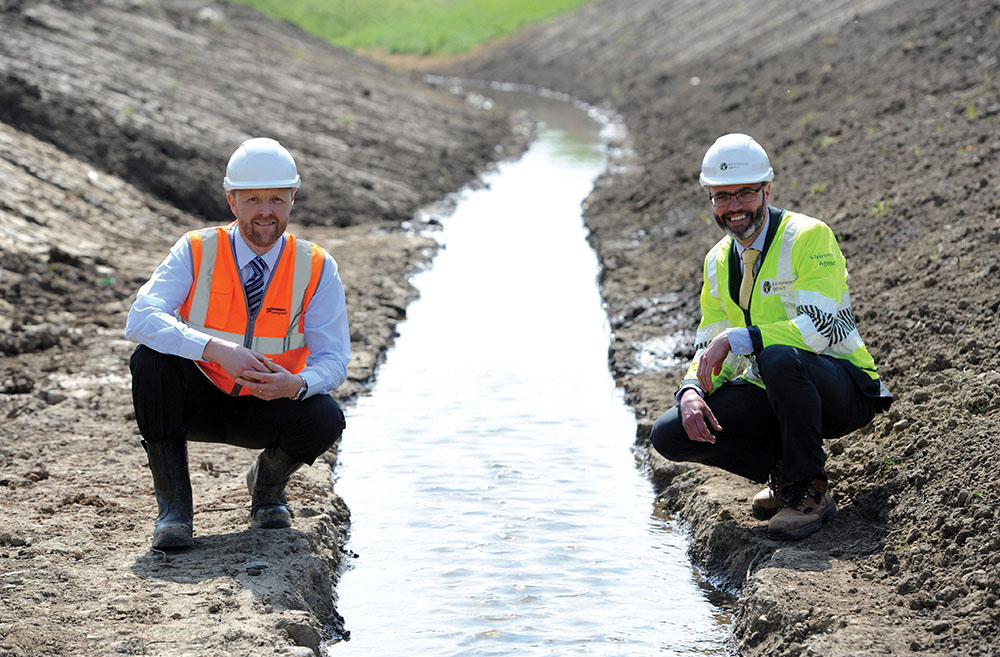
Northumbrian Water, which supplies 2.7 million customers in the North East with both water and sewerage services, places communities and the environment at its heart. It aims to provide a sewerage service that deals effectively with heavy rainfall, as well as meeting the needs of the current and future generations in a changing world.
Global threats, such as climate change, touch us all as we go about our daily lives and risks are becoming increasingly unpredictable and unknown. Lesser considered, is the impact that a warming atmosphere can have on the increasing amounts of rainfall, yet the Climate Change Risk Assessment predicts an increase in property flooding of 40% by 2080 if action is not taken to mitigate it.
These pressures were brought to light on 28 June 2012, when “Thunder Thursday” caused £8 million worth of damage to homes, roads and businesses, with three inches – over a month’s worth – of rain falling on Tyneside in just over an hour. The images of the flood-swept streets of Newcastle that day, highlighted that flooding isn’t merely an issue of inconvenience or property damage, but can be a direct threat to human life.
Resilience has formed a major part of Northumbrian Water’s Business Plan 2020-2025 and one of the ambitions to increase resilience is by proactively reducing flood risk to customers who may not have previously flooded, but may be at risk of flooding in future.
Managing surface water before it enters the sewer network is one of the key ways to help reduce sewer flood risk and free up capacity in the drainage network. The company’s ‘Rainwise’ initiative aims to tackle the challenges of urban creep and climate change, where the risk of flooding is heightened in urban areas with impermeable surfaces forcing water to quickly run off into sewer systems.
Sustainable drainage solutions (or SuDS) are used to slow down surface water run-off but Rainwise aims to build awareness of surface water management, ensuring the public understand how they can impact flood risk in their own communities too. It includes the simple steps customers can take to manage rainfall around their homes and in their community, such as the installation of water butts, planters and rain gardens, and places a big emphasis on schools which often have great potential to be home to SuDS projects.
Steena Nasapen-Watson, Sustainable Sewerage Manager at Northumbrian Water Group, said: “Rainwise is both a proactive and reactive initiative to reduce flood risk and influence customer behavioural change, aimed at increasing the resilience of our communities, reducing flooding through alleviating the pressure on our network.
“Thinking about the resilience of our services over the long term is not new to us and already in AMP6 our Rainwise approach has reduced flood risk to more than 4,000 properties. It brings together all of our drainage flood risk reduction initiatives, including our industry-leading and award-winning partnership projects. By creating the Rainwise brand, it provides an identity to customers, building awareness of surface water management and the steps they can take to manage water around their homes and communities more effectively.”
Incorporated in Rainwise is the award-winning Northumbria Integrated Drainage Partnership (NIDP). Northumbrian Water led the development of the NIDP, a regional partnership consisting of 13 Lead Local Flood Authorities in the North East and the Environment Agency. This multi-agency approach has provided a framework for integrated studies, which progress into reactive and proactive flood risk reduction schemes, looking for the best and most sustainable solutions to help address flood risk from all sources. It includes a robust scoring system so that costs and benefits are better understood and prioritised on a like-for-like basis.
Putting theory into practice
Northumbrian Water’s partnership approach has shown that joining forces with other agencies to tackle flooding can help deliver multiple social, economic and environmental benefits, including unlocking investment for projects that might not otherwise be feasible.
The organisation, which won a Judge’s Commendation by the British Quality Foundation for Innovation in Sustainability and Society earlier this year, has been recognised as leading in this area by stakeholders such as DEFRA and UKWIR, with example schemes including Brunton Park in Newcastle, and at Killingworth and Longbenton.
At Brunton Park, traditional capacity upgrades were complemented by innovative and sustainable work, including the unique diversion of part of the River Ouseburn in partnership with the Environment Agency and Newcastle City Council.
As a result, the scheme has reduced the risk of property flooding to more than 100 homes from multiple sources, providing up to 200 year protection from fluvial flooding and 40 year protection from the surface water and foul systems. It has additional environmental benefits including the management of surface water in the natural environment and the creation of additional water-dependent habitat. The scheme has provided lasting improvements to the amenity of the golf course it is located on, with the incorporation of the new channel and other features creating two key feature holes, something that the club were exceptionally pleased with.
Brunton Park has also been included in the Blue Green Cities consortium research, with the findings leading to Newcastle City Council, the Environment Agency and Northumbrian Water along with other partners to come together and be the first organisations in the country to explicitly commit to installing SuDS wherever possible.
At Killingworth and Longbenton, the aim of the £5 million three-phased project, led by Northumbrian Water in partnership with North Tyneside Council and the Environment Agency, is to manage surface water and increase the capacity of the combined sewer, thereby reducing the risk of flooding during heavy rainfall.
The project, which is now in its final phase and due to be complete in April 2019, has involved removing a river from the combined sewerage system by diverting the flows to an adjacent river, creating 11,000m2 of surface water storage to ensure the transferred flows do not increase flood risk, and creating a new lake overflow area to manage flood risk while providing green space for people and wildlife.
Once it is finished, the project will reduce flood risk from very significant/significant, to moderate/low at 136 properties, and reduce discharges from the sewer network by 81,797m3 per year. There are other benefits related to these SuDS but they can be hard to consider and quantify. Some of these include carbon reduction, reduced energy consumption, improved health and wellbeing, education opportunities and less transport disruption as a result of flooding.
Steena Nasapen-Watson, added: “Increasing sustainability creates a hugely positive impact on the environment, as well as raising awareness of environmental issues, but not all of these outputs are easy to quantify. We have worked with academics through the Construction Industry Research and Information Association (CiRIA) to try and address this, putting the Killingworth and Longbenton project forward to be used as a case study in a research project which resulted in the CiRIA BeST tool. BeST promotes best practice and allows our partners to quantify and evaluate a wide range of benefits.”
Using the BeST tool, the estimated net present value of the benefits arising from the Killingworth and Longbenton project is £31.8m, giving a benefit cost ratio in the order of 8:1.
Rainwise projects share common characteristics and themes, all addressing catchment-wide flooding and flow management, valuing SuDS and natural systems. They each had a scenario which no single agency could have addressed on their own, or not without causing detriment to others, and have been delivered with capital efficiency to the parties, primarily through jointly sourcing engineering consultants and contractors.
The Rainwise principles are a fundamental building block of Northumbrian Water’s Business Plan, as the organisation aspires to create a pipeline of partnership projects of all scales which, as well as improving customers’ participation in engaging sustainability themselves. What the organisation is implementing in terms of proactivity has the potential to solve issues that haven’t actually become problems yet, and that’s true innovation in building resilience.





